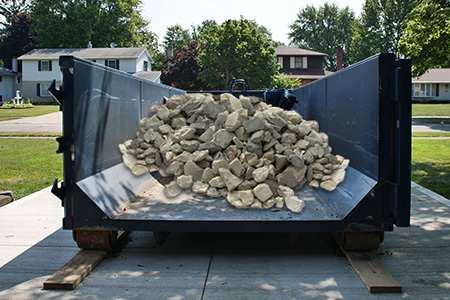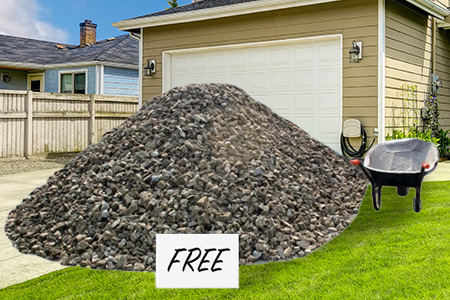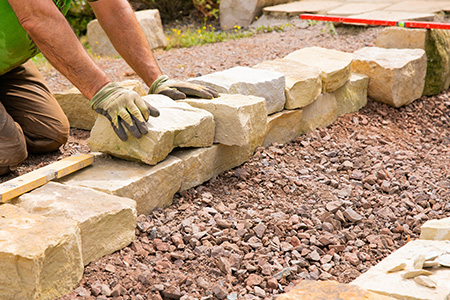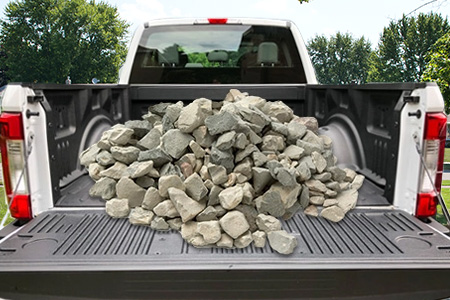
How to Dispose of Rocks
Have unwanted rocks and gravel lying around? Learn how to get rid of them with tips from the experts at Budget Dumpster.

The Complete Guide to Getting Rid of Rocks & Gravel
When starting a landscaping project, you’ll likely come across rocks in your yard, whether they’re buried in the dirt or part of existing hardscaping. We’ll walk you through the easiest and most budget-friendly ways to dispose of rock, from reusing them in a new landscaping project to renting a dumpster.
Ready to Rent a Dumpster? Order Online
7 Ways to Dispose of Extra Gravel and Rock
What’s the best way to get rid of rocks and gravel? Some disposal options cost nothing while others are labor-free. The details below can help you decide which choice is best for you.
![]()
Rent a Roll Off Dumpster
Pros: Upfront price and no landfill trips.
Cons: You fill the dumpster.
Cost: Starts at $217 per 10 yard bin.
![]()
Post Rocks Online
Pros: No cost to you.
Cons: You may have to deliver them.
Cost: Free.
![]()
Leave a “Free” Sign Out
Pros: You don’t have to haul rocks.
Cons: Pickup time is up to the buyer.
Cost: Free.
![]()
Give to a Landscape Supplier
Pros: You get rid of your rocks and repurpose them.
Cons: You’ll have to haul them to the landscaper.
Cost: Free.
![]()
Reuse in Your Landscaping
Pros: Environmentally friendly (reduce, reuse, recycle!).
Cons: Rocks don’t leave your home.
Cost: Free.
![]()
Hire a Junk Removal Company
Pros: They’ll do the heavy lifting.
Cons: You’ll have to pay per trip.
Cost: Starts at $450 per truckload.
![]()
Dump Them Yourself
Pros: You can work at your own pace.
Cons: Might take several trips to the landfill.
Cost: Starts at $37 per ton.
Rock Disposal Options
1. Rent a Roll Off Dumpster
Renting a dumpster is an easy and efficient way to dispose of rock and gravel. You can load a roll off dumpster with up to 10 tons of material at once, while a full-size pickup truck can only hold about 1 ton. So if you have a large amount of debris to get rid of, this is the way to go.
Please know that if you’re getting rid of heavy materials like rocks, a 10 yard roll off dumpster is probably your best option. Bigger containers may weigh too much to safely haul once they’re full of heavy rocks. Simply schedule your dumpster rental online, set a delivery date and load your rocks at your own pace. The best part? You won’t have to worry about making any trips to the landfill.

Benefits | Things to Consider |
|---|---|
You get an upfront, flat rate before your dumpster arrives. | Best for large amounts of debris. |
Lengthy rental periods make it easy to work at your own pace. | You will need to load your own materials. |
You have a set rock disposal schedule. | Dumpster sizes and weight limits can vary depending on your location. |
Getting Rid of a Lot of Rocks? Order Online
2. Post Rocks Online
An easy and free way to get rid of rocks is to post them to an online classifieds site. List your rocks and gravel for free and have someone pick them up, or post a delivery fee for extra cash in your pocket. You can create a digital listing on most sites. But for online forums, like Reddit, you’ll need to go to your city’s Subreddit to advertise your materials locally.
Get Rid of Rocks on These Sites:
Benefits | Things to Consider |
|---|---|
Free rock disposal option. | Isn't a guaranteed removal option. |
Allows for gravel and rock recycling. | Not ideal for large amounts of debris. |
Can make money by charging a delivery fee. | Debris removal time depends on the buyer. |
3. Leave a "Free" Sign Out
Leave your rocks outside your home in an easily accessible spot with a “Free” sign for your neighbors and other passersby to grab. If you’re part of a homeowners association, check that you are allowed to leave a sign and debris outside first.

Benefits | Things to Consider |
|---|---|
Free rock disposal option. | Isn't a guaranteed removal option. |
Very little extra work involved. | Leaves debris sitting out indefinitely. |
Allows people to recycle your rocks. | Takes up space in your front yard. |
4. Take Them to a Landscape Supplier
If your rocks are clean and in good shape, you may be able to dispose of them through a local landscaper or landscaping supply store. Depending on the quantity and quality of your materials, this can be a great way to dispose of rocks cheaply or for free and repurpose them. If your local landscaper charges a fee for rock recycling, you can also donate them to a local charity, like a Habitat for Humanity ReStore.
Benefits | Things to Consider |
|---|---|
Inexpensive or free rock disposal option. | You’ll have to haul your rocks there. |
You repurpose rocks without keeping them in your yard. | You may have to clean your rocks and gravel. |
If given to a charity, your donation may be tax deductible. | Best for a smaller amount of rocks. |
5. Reuse Them for Your Own Landscaping
A great way to repurpose unwanted debris is to reuse rocks and gravel in your own landscaping. Recycling rocks gets heavy debris out of the way and transforms it into a new garden feature.
Ways to Repurpose Rocks in Your Yard
Looking to put your old landscaping materials to good use? Recycling is a great way to do it. Here are a few creative (and free!) ways to dispose of rocks and gravel.
- Use larger rocks to create a low-budget backyard fire pit.
- Reuse gravel in your xeriscape landscaping.
- Recycle backyard rocks to form a footpath.
- Create a low-maintenance pathway with gravel.
By repurposing your rocks, you’ll save on both disposal and new project costs.

Benefits | Things to Consider |
|---|---|
You don’t have to pay for disposal. | You aren’t actually getting rid of rocks and gravel. |
You’re recycling rocks and gravel. | You may have more debris than you need for reuse. |
Repurposed rocks and gravel keep new landscaping project costs low. | The rocks you remove may not be ideal for the project you’re considering. |
6. Hire a Junk Removal Company
Hiring a junk removal company is another way to get rid of rocks and gravel. They’ll come to you on a date that works for your disposal timeline and haul the heavy debris away so you keep your hands clean. However, you’ll have to pay per trip. Rocks are heavy, and sometimes the company can’t fit as many rocks in their truck as they thought. Often the quoted price may change once they arrive on-site and see your debris in person. If you have a lot of rocks to get rid of, it may become a costly option.
Benefits | Things to Consider |
|---|---|
Heavy lifting is done for you. | Price may increase upon arrival. |
You can schedule disposal on your timeline. | Must be present for debris pickup. |
You don’t have to go to the landfill. | There may be a limit to how much debris you can dispose of. |
7. Dump the Rocks Yourself
Lastly, you can dispose of rocks and gravel at a landfill near you. Just make sure your local facility is open to the public and will take your heavy debris. Some county landfills offer free dump days a few times a year. Keep in mind, you’ll need a truck and some help from friends and family to load your materials and haul them to the dump. Depending on how much rock and gravel you have, this could take multiple trips.

Benefits | Things to Consider |
|---|---|
Low-cost disposal option for small amounts of rock. | You need a truck to transport your materials. |
You can work at your own pace. | It might take multiple trips. |
Landfill may be far away. |
How Much Does Rock Removal Cost?
The average cost of rock and gravel disposal depends on the amount of debris you need to get rid of. Typically, the less rock you have, the lower the cost.
If you have a lot of heavy debris, consider renting a roll off dumpster or hiring a junk removal company.
- A junk removal service usually costs between $450 and $650 to get rid of a full truckload of debris.
- In contrast, a 10 yard dumpster rental can usually haul up to 10 tons of rocks and gravel at an average cost of $410.
There are also several free options for disposing of rock. But keep in mind these disposal methods will require some heavy lifting on your part.
Costs of Various Rock Disposal Methods
Disposal Option | Unit | Average Cost |
|---|---|---|
| | |
| | |
| | |
| | |
| | |
| | |
| | |
Ready to Order Your Dumpster? Order Online
Frequently Asked Questions About Rock Disposal
What dumpster size is best for rock disposal?
The best roll off dumpster size for rock disposal is a 10 cubic yard bin. Rock and gravel are heavy. Filling a larger container with rock will make the dumpster too heavy for pickup. Dumpsters are limited to 10 tons of debris on the roadway, and each roll off container also has its own weight limit. Typically, you’ll only be able to fill your bin partway with heavy debris like rock and gravel. If a 10 yard bin isn’t large enough for your materials, use our convenient empty-and-return service to swap your full dumpster out for an empty one.
Where can I dump rocks?
You can dump rocks at any of the following locations:
- Local landfills and recycling centers that accept mixed heavy debris
- Landscapers or suppliers that accept rocks or gravel from the public
- Home improvement stores that sell recycled materials
- Habitat for Humanity ReStores
You should not dispose of rocks at:
- Local parks or public property
- Private property, other than your own
Can I recycle landscaping rocks?
Yes. You can recycle landscaping rocks by reusing them in your own outdoor projects. If you’d like to make a few extra bucks, consider selling them online. Or you can always donate your clean rocks and gravel to one of the following places:
- Habitat for Humanity ReStores
- Local landscape suppliers
- Home improvement stores that sell recycled debris
- Your neighborhood
Can I mix other items with rocks in a roll off dumpster?
Whether you can mix rocks with other materials in a dumpster depends on your location. Some areas can take mixed heavy waste, including rock, gravel, concrete, brick and other building materials, all in one container. In other places, there are dumpsters just for rocks and gravel. Reach out to our team to learn more, or order online to see what rock disposal options are available in your area.
It depends on your local government. Some places prohibit landscaping materials in your typical household waste bin. Other areas might have weight restrictions and allow a small amount of rock or gravel mixed in with your waste each week. Contact your local municipality to see if they accept rock and gravel in your weekly trash pickup.








